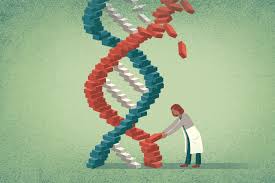In the quiet corridors of our most advanced laboratories, a revolution not of machinery and steam but of genes and life itself unfolds with a subtle ferocity. The tool at the forefront, CRISPR, acts not with the clang of industrial age gears but with the precision of a sculptor, albeit one whose medium is the very code of life.
The Dawn of CRISPR: A New Era in Science
Imagine a world where genetic diseases are merely a memory, where crops withstand changing climates without a whimper, and where medicine is tailored not just to a country or a community, but to the single, beating heart of an individual. This is the world promised by CRISPR and other gene-editing technologies. Yet, as with any powerful tool, the brighter the light, the darker the potential shadows cast.
The story of CRISPR began not in a human mind, but as a humble part of bacterial immune systems, a discovery that scientists adapted into a tool capable of cutting and editing DNA strands. The real-life implications of this are profound. Children born today with conditions like cystic fibrosis or Duchenne muscular dystrophy could, in the future, have their conditions edited away before the symptoms ever surface.
Balancing Act: The Ethical Frontier
With great power comes great responsibility—a cliché, yes, but never truer than in the hands of those who wield genetic editing tools. The ethical implications of CRISPR are as complex as the DNA it seeks to edit. Consider the controversy sparked by the creation of the first gene-edited babies in China. The scientist behind it, He Jiankui, stepped beyond the bounds of medical ethics into a realm many likened to playing God.
The key ethical challenge here lies in distinguishing between therapy and enhancement. Curing disease is one thing; tailoring traits, another. Where do we draw the line? And who decides? These questions weave a tangled web, as complex as the DNA helix itself.
Revolution in Medicine: CRISPR’s Potential
Beyond the ethical labyrinth lies a vista of medical miracles. CRISPR’s ability to accurately alter the genetic foundations of life holds promises of a paradigm shift in medicine. The application of ai medical pictures in training algorithms to recognize genetic disorders from imaging studies merges this new frontier with the digital, creating a synergy that can lead to unprecedented diagnostic tools.
These technologies foster a technopunk reality—a blend of advanced technological landscapes with the raw, individualistic ethos of punk. Here, personal empowerment through technology isn’t just a dream; it’s an emerging reality.
Technopunk and Genetic Autonomy
In the technopunk vision, genetic editing becomes more than a medical tool—it’s an expression of personal autonomy and rebellion against societal norms. This genre imagines a world where individuals use genetic technologies to customize their bodies and abilities, much like altering digital avatars. Here, the act of editing genes aligns with technopunk’s ethos of individuality and resistance, turning the human genome into a canvas for personal expression and technological artistry.
Ethical Dilemmas in a Technopunk Reality
The integration of technopunk and genetic editing raises stark ethical questions. What if only the affluent can afford genetic enhancements? Technopunk scenarios often explore these divides, painting a picture of a future where genetic modifications could lead to new forms of inequality. As we approach the possibility of such a future, the need for rigorous ethical oversight and equitable access becomes crucial. This narrative is not just about the potential of genetic technologies but also about ensuring they don’t exacerbate social divides or infringe on personal freedoms.
CRISPR in Agriculture: Feeding the Future
In the fields of the world, genetic editing crafts plants that can do more than just survive; they thrive. Crops edited to resist pests and tolerate harsh conditions are already under development, promising a future where hunger is not an inevitable scourge but a solvable challenge. This aspect of CRISPR could reshape agriculture, making it more sustainable and efficient as the global population continues to climb.
A Future Forged by Choice
The journey of genetic editing is much like walking through a dense fog—the path is unclear and the potential missteps many. Public dialogue and regulation must pace with scientific advancement. We stand on the brink of rewriting life’s rulebook; what we inscribe in it will narrate the future of our species.
Every new technology carries its freight of hope and hazard, and CRISPR is no exception. It whispers of a world free of genetic diseases, of crops that do not falter in the face of climatic cruelty, of treatments tailored so finely to the individual that they are less like medicine and more like a key fitting into a lock.
Yet in this whisper there is a caution, a reminder that the power to edit life is also the power to overwrite millennia of evolutionary balance. The ethical debates and regulatory frameworks we construct today will guide this potent new tool, ensuring it heals more than harms.
As we continue to explore the vast potential of genetic editing, we must do so with a sense of grave responsibility and profound respect for the complexity of life. The future, indeed, is in our hands; let us handle it with care.




